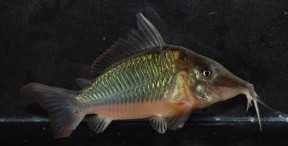Corydoras multiradiatus
Hognose 'Brochis'
SynonymsTop ↑
Chaenothorax multiradiatus Orcés V., 1960; Brochis multiradiatus (Orcés V., 1960)
Etymology
Corydoras: from the Ancient Greek κόρυς (korus), meaning ‘helmet’, and δορά (dora), meaning ‘skin, hide of an animal’, in allusion to the rows of bony plates on the flanks of genus members.
multiradiatus: from the Latin multi, meaning ‘many’, and radiatus, meaning ‘radiated’, in reference to the high number of dorsal-fin rays in this species.
Classification
Order: Siluriformes Family: Callichthyidae
Distribution
Native to tributaries of the northwestern Amazon basin in Ecuador and Peru
Type locality is ‘Tributary of Río Lagartococha near town of Garza-Cocha, upper Río Napo system, Province Napo, Ecuador’.
Habitat
The only information provided by Orcés V. is that the type series was collected at 200-250 m AMSL, but this species is likely to form aggregations in smaller tributaries and still bodies of water such as backwaters, oxbows and marginal lakes, similar to closely-related species.
Maximum Standard Length
80 – 100 mm.
Aquarium SizeTop ↑
Minimum dimensions of 120 ∗ 45 ∗ 45 cm or equivalent are recommended.
Maintenance
Ideally use a substrate of fine sand, although rounded gravel is an acceptable alternative provided it is kept scrupulously clean.
Other décor is largely down to personal choice, but some cover should be provided to give the fish security.
Water Conditions
Temperature: 20 – 26 °C
pH: 6.0 – 7.5
Hardness: 36 – 215 ppm
Diet
Corydoras spp. are foraging omnivores and will accept most sinking dried foods, as well as small live and frozen varieties such as chironomid larvae (bloodworm), Tubifex, etc.
Feeding a varied diet will ensure the fish are in optimum condition.
Under no circumstances should they be expected to survive on ‘left-overs’ from other inhabitants of the aquarium or relied on to ‘clean’ the aquarium.
Behaviour and CompatibilityTop ↑
Peaceful and gregarious. Should be maintained in a group of at least 6-8 individuals.
Sexual Dimorphism
Adult females are noticeably rounder, higher-bodied, and grow slightly larger than males.
Reproduction
Unreported.
NotesTop ↑
This species was formerly classified in the genus Brochis and is sometimes referred to as ‘long-finned brochis’.
C. multiradiatus can be distinguished from other ex-Brochis species by the extended snout and possession of 17-18 dorsal-fin rays (vs. 10-12 in C. splendens and 15-18, normally 15, in C. britskii). All other members of the genus Corydoras, as well as the closely-related Aspidoras and Scleromystax, possess 6-8 dorsal-fin rays.
Brochis was first synonymised with Corydoras by Britto (2003), since the latter genus cannot be considered monophyletic if the former is accepted as valid. This decision has been supported in subsequent phylogenetic studies by Shimabukuro-Dias et al. (2004) and Alexandrou et al. (2011), although the name Brochis is still common in aquarium literature. It is likely that the genus will be revalidated and expanded in the future following a required taxonomic review of the subfamily Corydoradinae as suggested by Alexandrou and Taylor (2011).
The genus is included in the family Callichthyidae, of which members are often referred to collectively as ‘armoured’ or ‘mailed’ catfishes group due to the presence of bony plates in place of scales on the body. Their taxonomy can be confusing, and numerous undescribed species are also thought to exist. Fish of unconfirmed identification entering the aquarium hobby are therefore typically assigned a ‘C‘ or ‘CW‘ number for purposes of reference and organisation.
They are facultative air breathers and possess a modified, highly vascularised intestine which has evolved to facilitate uptake of atmospheric oxygen and aid survival in oxygen-deprived environments. In the aquarium you’ll occasionally see them rising to the surface to take in gulps of air.
The stiffened pectoral-fin spines are capable of piercing human skin and a ‘sting’ can be very painful indeed, so care should be exercised when handling them. It’s thought that secretions from the axillary glands at the base of each spine may even be mildly toxic or venomous.
References
- Orcés V., G., 1960 - Ciencia y Naturaleza (Quito) v. 3: 2-6
Peces ecuatorianos de la familia Callichthyidae, con la descripción de una especie nueva. - Alexandrou, M. A. and M. I. Taylor, 2011 - Verlag A.C.S. GmbH: 101-114
Evolution, Ecology and Taxonomy of the Corydoradinae Revisited. In: Identifying Corydoradinae Catfish. - Alexandrou, M. A., C. Oliveira, M. Maillard, R. A. R. McGill, J. Newton, S. Creer and M. I. Taylor , 2011 - Nature 469(7328): 84-88
Competition and phylogeny determine community structure in Müllerian co-mimics. - Britto, M. R., 2003 - Proceedings of the Academy of Natural Sciences of Philadelphia 153: 118-154
Phylogeny of the subfamily Corydoradinae Hoedeman, 1952 (Siluriformes: Callichthyidae), with a definition of its genera. - Ferraris, C. J., Jr., 2007 - Zootaxa 1418: 1-628
Checklist of catfishes, recent and fossil (Osteichthyes: Siluriformes), and catalogue of siluriform primary types. - Fuller, I. A. M., and H-G. Evers, 2005 - Verlag A.C.S. GmbH: 1-384
Identifying Corydoradinae Catfish. - Hoedeman, J. J., 1952 - Beaufortia 1(12): 1-11
Notes on the Ichthyology of Surinam (Dutch Guiana). The Catfish genera Hoplosternum and Callichthys, with key to the genera and groups of the family Callichthyidae. - Reis, R. E., 1998 - Zoological Journal of the Linnean Society 124(2): 105-168
Anatomy and phylogenetic analysis of the neotropical callichthyid catfishes (Ostariophysi, Siluriformes). - Reis, R. E., S. O. Kullander and C. J. Ferraris, Jr. (eds), 2003 - EDIPUCRS, Porto Alegre: i-xi + 1-729
Check list of the freshwater fishes of South and Central America. CLOFFSCA. - Shimabukuro-Dias, C. K., C. Oliveira, R. E. Reis and F. Foresti , 2004 - Molecular Phylogenetics and Evolution 32(1): 152-163
Molecular phylogeny of the armored catfish family Callichthyidae (Ostariophysi, Siluriformes).






